History of Slavery in America: Colonial Roots, Civil War, and Beyond
VerifiedAdded on 2023/06/09
|5
|1183
|487
Essay
AI Summary
This essay provides a comprehensive overview of the history of slavery in America, tracing its origins in the early colonial period through its expansion in the 18th and 19th centuries. The essay examines the economic factors that fueled slavery, such as the rise of cotton plantations and the demand for raw materials in the British textile industry. It explores the social and political dimensions of slavery, including the pro-slavery attitudes of the Southern states and the role of democracy in defending the institution. The essay also discusses the efforts to abolish slavery, including the role of figures like William Wilberforce. The essay concludes by emphasizing the long-lasting impact of slavery on American society and the missed opportunities for earlier abolition, highlighting the unequal distribution of literacy and industrial developments across the country as a key factor. The provided document is a student essay available on Desklib, a platform offering AI-based study tools, past papers, and solved assignments.
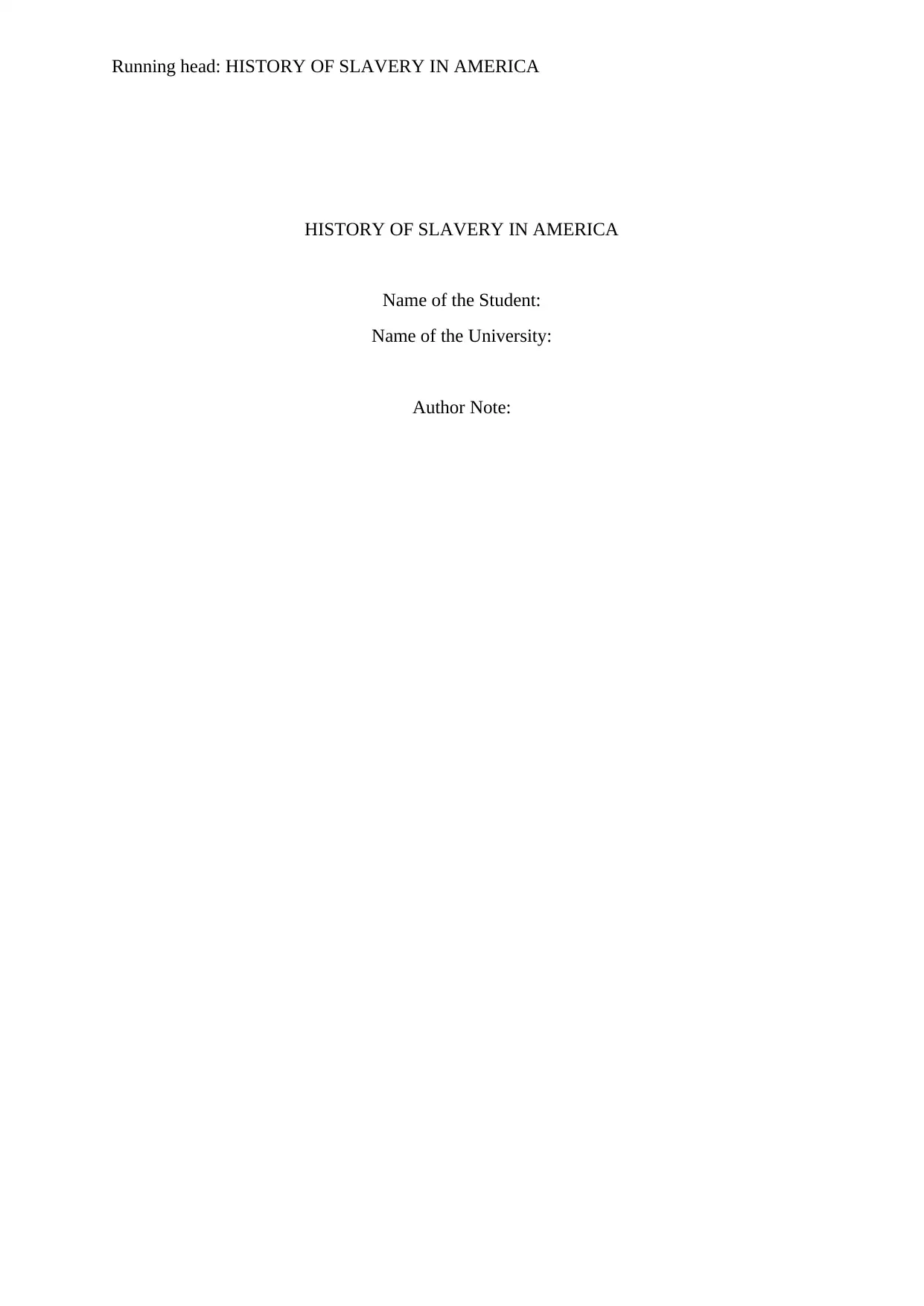
Running head: HISTORY OF SLAVERY IN AMERICA
HISTORY OF SLAVERY IN AMERICA
Name of the Student:
Name of the University:
Author Note:
HISTORY OF SLAVERY IN AMERICA
Name of the Student:
Name of the University:
Author Note:
Paraphrase This Document
Need a fresh take? Get an instant paraphrase of this document with our AI Paraphraser
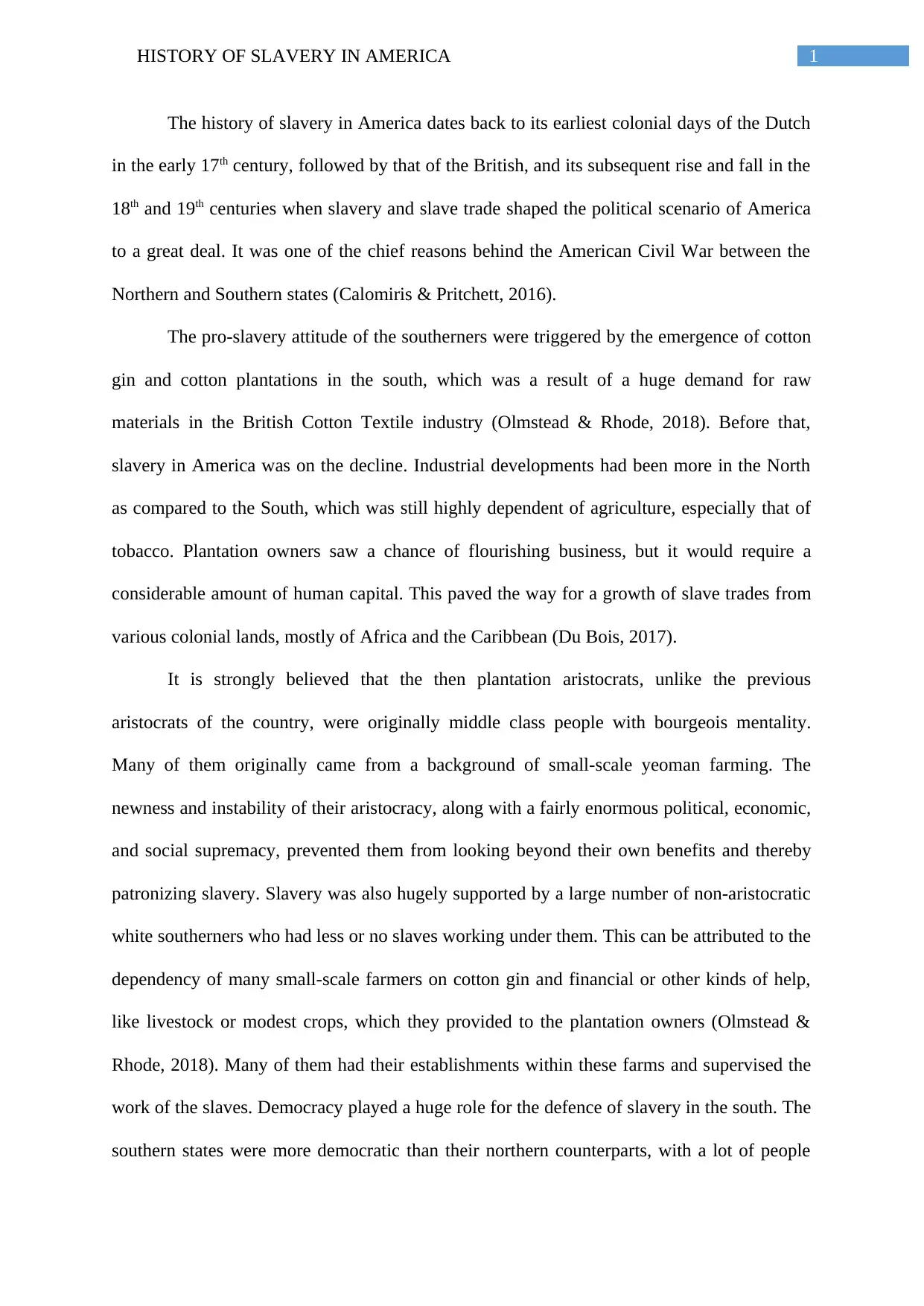
1HISTORY OF SLAVERY IN AMERICA
The history of slavery in America dates back to its earliest colonial days of the Dutch
in the early 17th century, followed by that of the British, and its subsequent rise and fall in the
18th and 19th centuries when slavery and slave trade shaped the political scenario of America
to a great deal. It was one of the chief reasons behind the American Civil War between the
Northern and Southern states (Calomiris & Pritchett, 2016).
The pro-slavery attitude of the southerners were triggered by the emergence of cotton
gin and cotton plantations in the south, which was a result of a huge demand for raw
materials in the British Cotton Textile industry (Olmstead & Rhode, 2018). Before that,
slavery in America was on the decline. Industrial developments had been more in the North
as compared to the South, which was still highly dependent of agriculture, especially that of
tobacco. Plantation owners saw a chance of flourishing business, but it would require a
considerable amount of human capital. This paved the way for a growth of slave trades from
various colonial lands, mostly of Africa and the Caribbean (Du Bois, 2017).
It is strongly believed that the then plantation aristocrats, unlike the previous
aristocrats of the country, were originally middle class people with bourgeois mentality.
Many of them originally came from a background of small-scale yeoman farming. The
newness and instability of their aristocracy, along with a fairly enormous political, economic,
and social supremacy, prevented them from looking beyond their own benefits and thereby
patronizing slavery. Slavery was also hugely supported by a large number of non-aristocratic
white southerners who had less or no slaves working under them. This can be attributed to the
dependency of many small-scale farmers on cotton gin and financial or other kinds of help,
like livestock or modest crops, which they provided to the plantation owners (Olmstead &
Rhode, 2018). Many of them had their establishments within these farms and supervised the
work of the slaves. Democracy played a huge role for the defence of slavery in the south. The
southern states were more democratic than their northern counterparts, with a lot of people
The history of slavery in America dates back to its earliest colonial days of the Dutch
in the early 17th century, followed by that of the British, and its subsequent rise and fall in the
18th and 19th centuries when slavery and slave trade shaped the political scenario of America
to a great deal. It was one of the chief reasons behind the American Civil War between the
Northern and Southern states (Calomiris & Pritchett, 2016).
The pro-slavery attitude of the southerners were triggered by the emergence of cotton
gin and cotton plantations in the south, which was a result of a huge demand for raw
materials in the British Cotton Textile industry (Olmstead & Rhode, 2018). Before that,
slavery in America was on the decline. Industrial developments had been more in the North
as compared to the South, which was still highly dependent of agriculture, especially that of
tobacco. Plantation owners saw a chance of flourishing business, but it would require a
considerable amount of human capital. This paved the way for a growth of slave trades from
various colonial lands, mostly of Africa and the Caribbean (Du Bois, 2017).
It is strongly believed that the then plantation aristocrats, unlike the previous
aristocrats of the country, were originally middle class people with bourgeois mentality.
Many of them originally came from a background of small-scale yeoman farming. The
newness and instability of their aristocracy, along with a fairly enormous political, economic,
and social supremacy, prevented them from looking beyond their own benefits and thereby
patronizing slavery. Slavery was also hugely supported by a large number of non-aristocratic
white southerners who had less or no slaves working under them. This can be attributed to the
dependency of many small-scale farmers on cotton gin and financial or other kinds of help,
like livestock or modest crops, which they provided to the plantation owners (Olmstead &
Rhode, 2018). Many of them had their establishments within these farms and supervised the
work of the slaves. Democracy played a huge role for the defence of slavery in the south. The
southern states were more democratic than their northern counterparts, with a lot of people
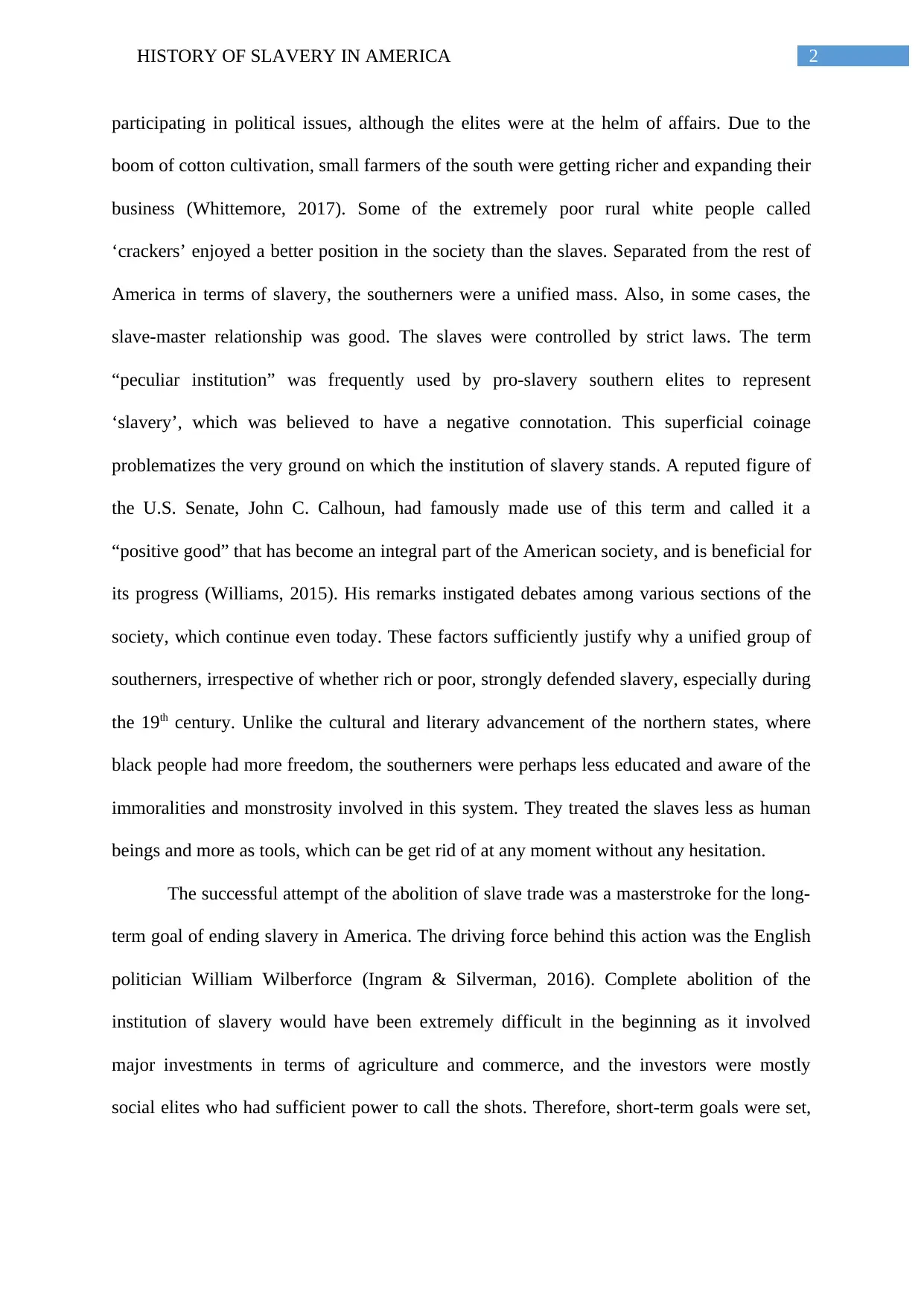
2HISTORY OF SLAVERY IN AMERICA
participating in political issues, although the elites were at the helm of affairs. Due to the
boom of cotton cultivation, small farmers of the south were getting richer and expanding their
business (Whittemore, 2017). Some of the extremely poor rural white people called
‘crackers’ enjoyed a better position in the society than the slaves. Separated from the rest of
America in terms of slavery, the southerners were a unified mass. Also, in some cases, the
slave-master relationship was good. The slaves were controlled by strict laws. The term
“peculiar institution” was frequently used by pro-slavery southern elites to represent
‘slavery’, which was believed to have a negative connotation. This superficial coinage
problematizes the very ground on which the institution of slavery stands. A reputed figure of
the U.S. Senate, John C. Calhoun, had famously made use of this term and called it a
“positive good” that has become an integral part of the American society, and is beneficial for
its progress (Williams, 2015). His remarks instigated debates among various sections of the
society, which continue even today. These factors sufficiently justify why a unified group of
southerners, irrespective of whether rich or poor, strongly defended slavery, especially during
the 19th century. Unlike the cultural and literary advancement of the northern states, where
black people had more freedom, the southerners were perhaps less educated and aware of the
immoralities and monstrosity involved in this system. They treated the slaves less as human
beings and more as tools, which can be get rid of at any moment without any hesitation.
The successful attempt of the abolition of slave trade was a masterstroke for the long-
term goal of ending slavery in America. The driving force behind this action was the English
politician William Wilberforce (Ingram & Silverman, 2016). Complete abolition of the
institution of slavery would have been extremely difficult in the beginning as it involved
major investments in terms of agriculture and commerce, and the investors were mostly
social elites who had sufficient power to call the shots. Therefore, short-term goals were set,
participating in political issues, although the elites were at the helm of affairs. Due to the
boom of cotton cultivation, small farmers of the south were getting richer and expanding their
business (Whittemore, 2017). Some of the extremely poor rural white people called
‘crackers’ enjoyed a better position in the society than the slaves. Separated from the rest of
America in terms of slavery, the southerners were a unified mass. Also, in some cases, the
slave-master relationship was good. The slaves were controlled by strict laws. The term
“peculiar institution” was frequently used by pro-slavery southern elites to represent
‘slavery’, which was believed to have a negative connotation. This superficial coinage
problematizes the very ground on which the institution of slavery stands. A reputed figure of
the U.S. Senate, John C. Calhoun, had famously made use of this term and called it a
“positive good” that has become an integral part of the American society, and is beneficial for
its progress (Williams, 2015). His remarks instigated debates among various sections of the
society, which continue even today. These factors sufficiently justify why a unified group of
southerners, irrespective of whether rich or poor, strongly defended slavery, especially during
the 19th century. Unlike the cultural and literary advancement of the northern states, where
black people had more freedom, the southerners were perhaps less educated and aware of the
immoralities and monstrosity involved in this system. They treated the slaves less as human
beings and more as tools, which can be get rid of at any moment without any hesitation.
The successful attempt of the abolition of slave trade was a masterstroke for the long-
term goal of ending slavery in America. The driving force behind this action was the English
politician William Wilberforce (Ingram & Silverman, 2016). Complete abolition of the
institution of slavery would have been extremely difficult in the beginning as it involved
major investments in terms of agriculture and commerce, and the investors were mostly
social elites who had sufficient power to call the shots. Therefore, short-term goals were set,
⊘ This is a preview!⊘
Do you want full access?
Subscribe today to unlock all pages.

Trusted by 1+ million students worldwide
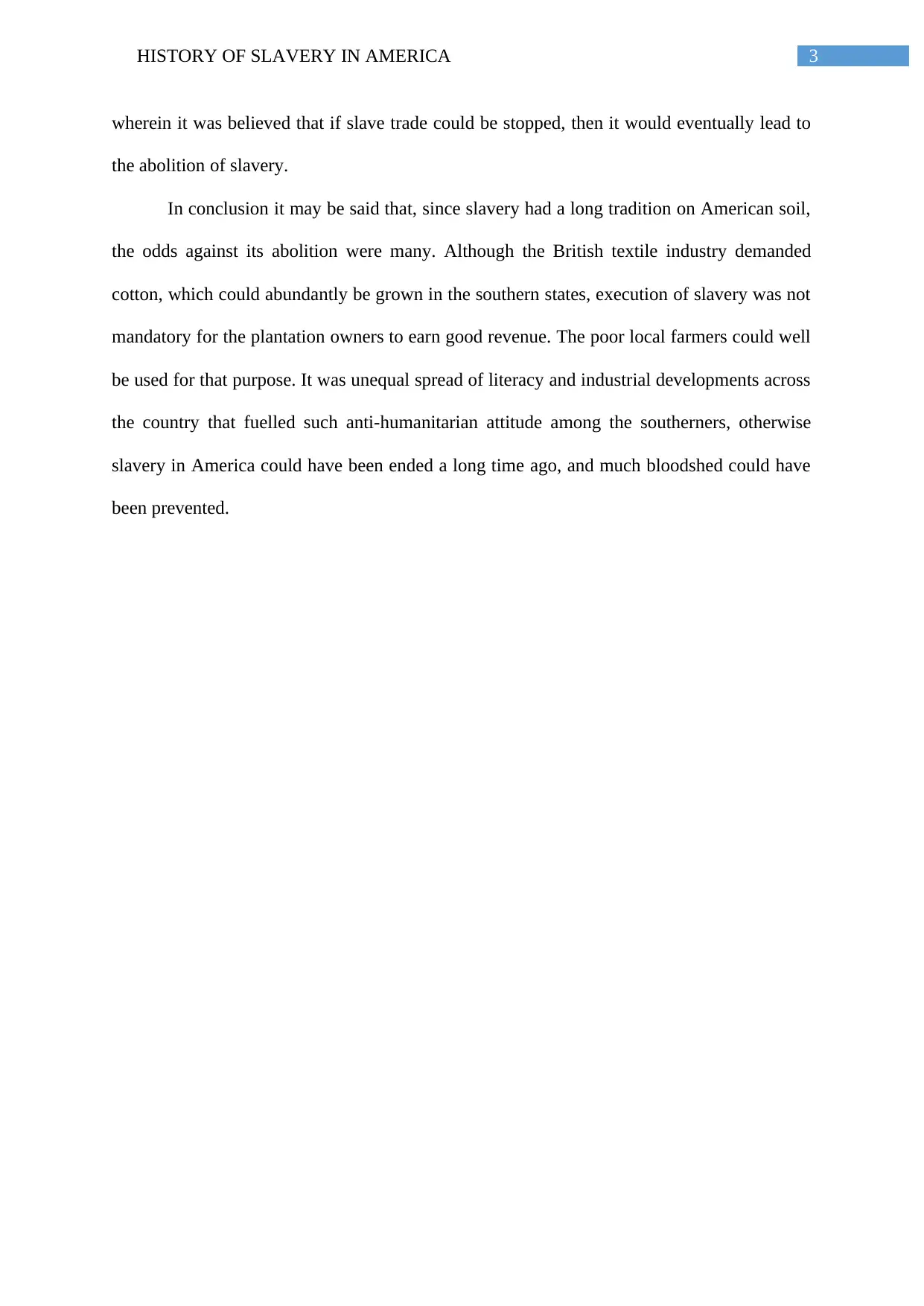
3HISTORY OF SLAVERY IN AMERICA
wherein it was believed that if slave trade could be stopped, then it would eventually lead to
the abolition of slavery.
In conclusion it may be said that, since slavery had a long tradition on American soil,
the odds against its abolition were many. Although the British textile industry demanded
cotton, which could abundantly be grown in the southern states, execution of slavery was not
mandatory for the plantation owners to earn good revenue. The poor local farmers could well
be used for that purpose. It was unequal spread of literacy and industrial developments across
the country that fuelled such anti-humanitarian attitude among the southerners, otherwise
slavery in America could have been ended a long time ago, and much bloodshed could have
been prevented.
wherein it was believed that if slave trade could be stopped, then it would eventually lead to
the abolition of slavery.
In conclusion it may be said that, since slavery had a long tradition on American soil,
the odds against its abolition were many. Although the British textile industry demanded
cotton, which could abundantly be grown in the southern states, execution of slavery was not
mandatory for the plantation owners to earn good revenue. The poor local farmers could well
be used for that purpose. It was unequal spread of literacy and industrial developments across
the country that fuelled such anti-humanitarian attitude among the southerners, otherwise
slavery in America could have been ended a long time ago, and much bloodshed could have
been prevented.
Paraphrase This Document
Need a fresh take? Get an instant paraphrase of this document with our AI Paraphraser
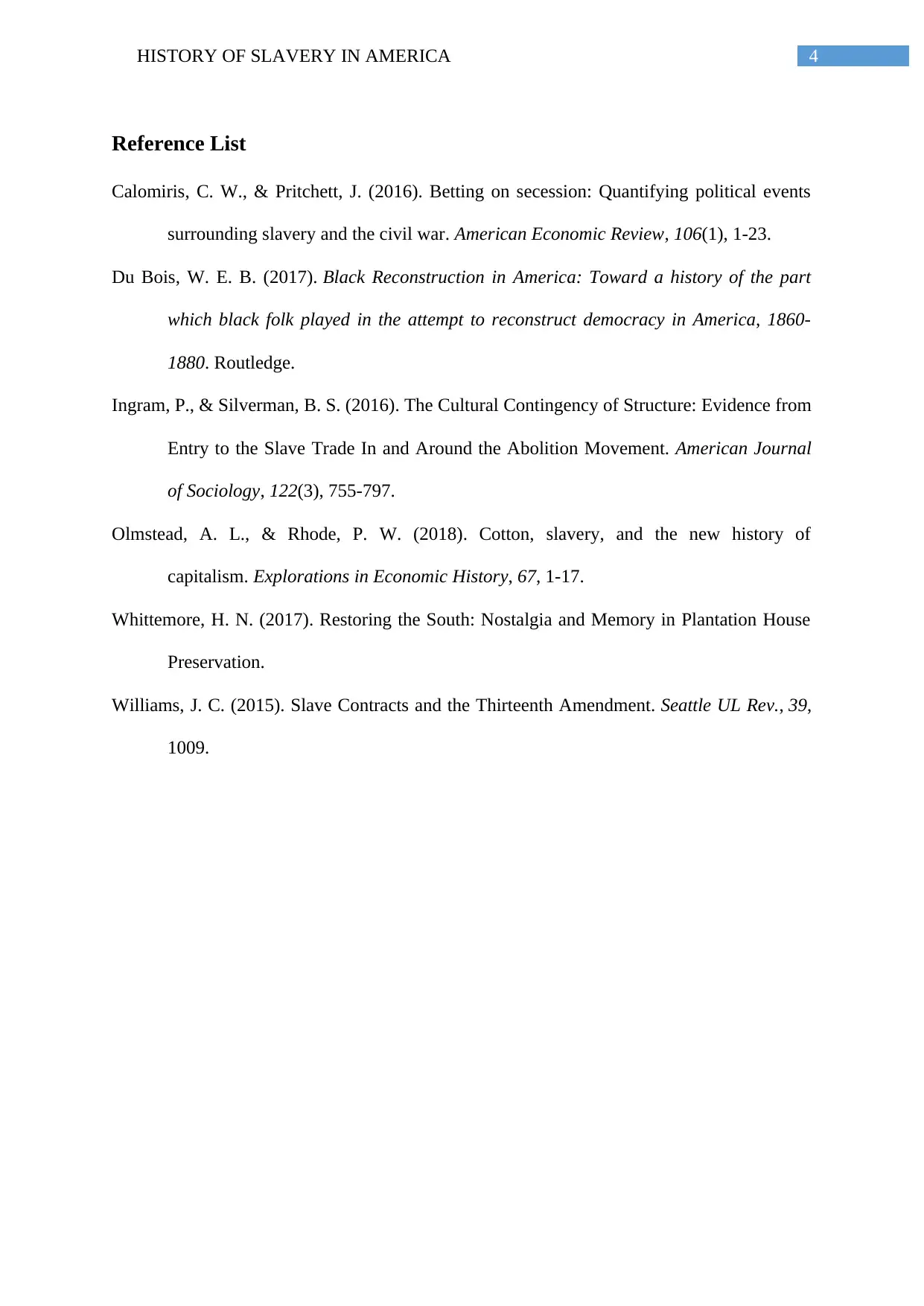
4HISTORY OF SLAVERY IN AMERICA
Reference List
Calomiris, C. W., & Pritchett, J. (2016). Betting on secession: Quantifying political events
surrounding slavery and the civil war. American Economic Review, 106(1), 1-23.
Du Bois, W. E. B. (2017). Black Reconstruction in America: Toward a history of the part
which black folk played in the attempt to reconstruct democracy in America, 1860-
1880. Routledge.
Ingram, P., & Silverman, B. S. (2016). The Cultural Contingency of Structure: Evidence from
Entry to the Slave Trade In and Around the Abolition Movement. American Journal
of Sociology, 122(3), 755-797.
Olmstead, A. L., & Rhode, P. W. (2018). Cotton, slavery, and the new history of
capitalism. Explorations in Economic History, 67, 1-17.
Whittemore, H. N. (2017). Restoring the South: Nostalgia and Memory in Plantation House
Preservation.
Williams, J. C. (2015). Slave Contracts and the Thirteenth Amendment. Seattle UL Rev., 39,
1009.
Reference List
Calomiris, C. W., & Pritchett, J. (2016). Betting on secession: Quantifying political events
surrounding slavery and the civil war. American Economic Review, 106(1), 1-23.
Du Bois, W. E. B. (2017). Black Reconstruction in America: Toward a history of the part
which black folk played in the attempt to reconstruct democracy in America, 1860-
1880. Routledge.
Ingram, P., & Silverman, B. S. (2016). The Cultural Contingency of Structure: Evidence from
Entry to the Slave Trade In and Around the Abolition Movement. American Journal
of Sociology, 122(3), 755-797.
Olmstead, A. L., & Rhode, P. W. (2018). Cotton, slavery, and the new history of
capitalism. Explorations in Economic History, 67, 1-17.
Whittemore, H. N. (2017). Restoring the South: Nostalgia and Memory in Plantation House
Preservation.
Williams, J. C. (2015). Slave Contracts and the Thirteenth Amendment. Seattle UL Rev., 39,
1009.
1 out of 5
Related Documents
Your All-in-One AI-Powered Toolkit for Academic Success.
+13062052269
info@desklib.com
Available 24*7 on WhatsApp / Email
![[object Object]](/_next/static/media/star-bottom.7253800d.svg)
Unlock your academic potential
Copyright © 2020–2025 A2Z Services. All Rights Reserved. Developed and managed by ZUCOL.





